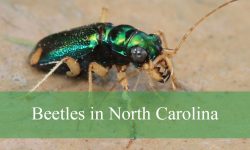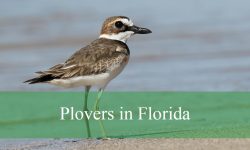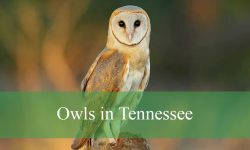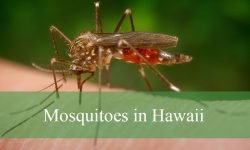California’s ponds, rivers, and wetlands come alive each summer with the shimmer of dragonflies. Their iridescent wings and swift, darting movements capture the magic of nature in motion. From coastal lagoons to desert springs, these insects add life and color wherever water glistens.
For those who enjoy quiet moments outdoors, watching dragonflies is a peaceful and rewarding experience. Each species has its own rhythm—some hover like tiny helicopters, others zip past in flashes of blue or red light. Their beauty and precision make them a joy to observe.
This guide introduces 30 species of dragonflies found across California, complete with photos and key identification details. It’s a visual journey through the state’s waterways, celebrating the diversity and elegance of these remarkable aerial hunters.
Types of Dragonflies Found in California
Blue Dasher (Pachydiplax longipennis)
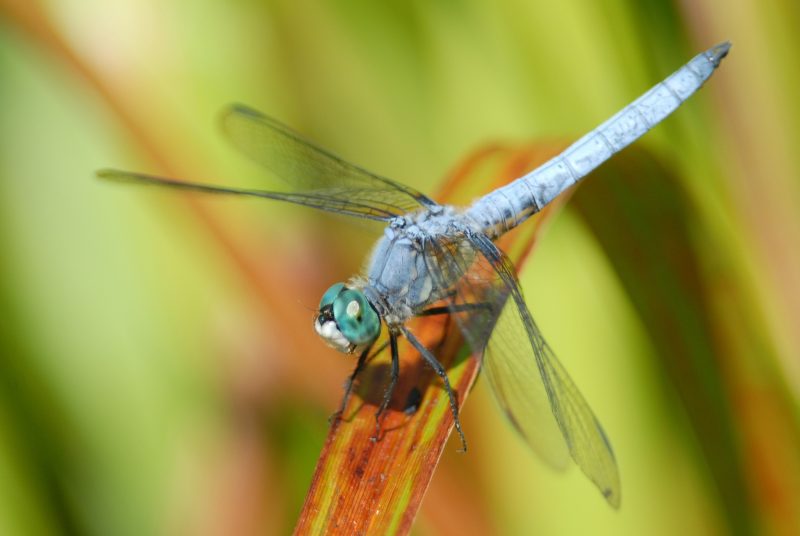
The Blue Dasher is a small but vibrantly colored dragonfly that brings flashes of blue and green to California’s wetlands. Adult males are recognized by their bright blue abdomens and metallic green faces, while females display brown bodies with yellow stripes. Measuring about 1.2 inches long, this species has a compact build and transparent wings with dark wingtips. Its short abdomen and quick, darting movements make it easy to distinguish from larger species.
Behaviorally, Blue Dashers are territorial and often perch on reeds or twigs near the water’s edge. Males defend their area fiercely, chasing away intruders with quick aerial maneuvers. They frequently return to the same perch, making them a favorite subject for photographers. Both adults and larvae are skilled predators that consume mosquitoes, small flies, and aquatic insects, playing an essential role in controlling insect populations.
In California, Blue Dashers are found throughout the state from the Central Valley to coastal wetlands. They thrive in calm, still waters—ponds, ditches, and marshes are their preferred habitats. Their adaptability allows them to survive even in urban parks and garden ponds, where they remain active from late spring through early autumn.
Flame Skimmer (Libellula saturata)
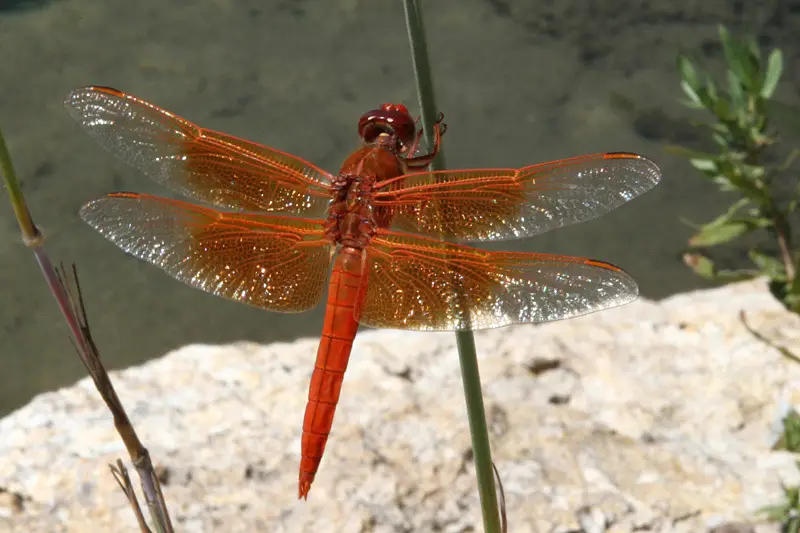
The Flame Skimmer, often called the “fire dragonfly,” is easily one of the most striking species in California. Males display brilliant orange-red bodies and wings that seem to glow in the sunlight. Females are typically duller, with amber-brown wings and lighter body tones. These large dragonflies measure about 2.5 to 3 inches in length, with broad wings and a thick abdomen, giving them a bold presence as they hover near water.
This species is known for its territorial behavior and its tendency to bask in direct sunlight. Males often patrol open stretches of warm ponds and creeks, perching on rocks or branches to guard their territories. Their flight is strong and deliberate, and they often return to the same perch repeatedly. Flame Skimmers are voracious hunters, feeding on mosquitoes, midges, and small flying insects caught midair.
Flame Skimmers are widespread throughout California, especially in southern and central regions where temperatures are high. They favor sunny, open habitats such as ponds, streams, and hot springs, often in low-elevation areas. Their nymphs develop in shallow waters with abundant vegetation, making these dragonflies a common sight in backyard ponds and natural springs during the summer months.
Common Green Darner (Anax junius)

The Common Green Darner is one of the largest and most recognizable dragonflies found in California. Adults measure about 2.8 to 3.1 inches in length, with a bright green thorax and a striking blue abdomen in males. Females can vary in color from blue to brownish tones. Their large, transparent wings allow powerful flight, and their large compound eyes give them exceptional vision. This dragonfly’s vivid coloration and size make it easy to spot even from a distance.
In terms of behavior, the Common Green Darner is highly active and known for its strong, fast, and purposeful flight. It’s one of the few dragonfly species that migrates, with some populations traveling thousands of miles between the U.S. and Mexico. During mating, males clasp females behind the head and form a heart-shaped “wheel” position while mating in midair or near water.
In California, these dragonflies inhabit lakes, ponds, and slow-moving streams from the coast to inland valleys. They are particularly common in warm, low-elevation wetlands but can also be found in mountain meadows during the summer. Their larvae, known as nymphs, live underwater where they prey on mosquito larvae and small aquatic insects, contributing significantly to local ecosystem balance.
Twelve-Spotted Skimmer (Libellula pulchella)
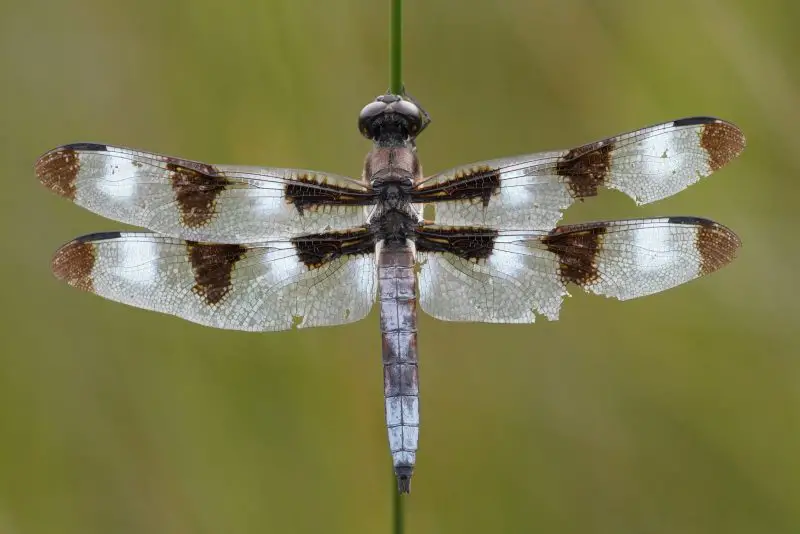
The Twelve-Spotted Skimmer is instantly recognizable by the twelve dark patches on its wings—three on each wing. Males also feature additional white patches between the dark ones, creating a bold black-and-white pattern when viewed in flight. Adults typically reach about 2 inches in length, with a sturdy body and broad wings. Their distinctive wing markings make them one of the easiest dragonflies to identify in the field.
In terms of behavior, these dragonflies are strong fliers but tend to hover or glide slowly near the surface of calm waters. Males are highly territorial, often patrolling small sections of ponds or marshes. Females are more secretive, visiting water primarily for mating and egg-laying. Both adults and larvae are efficient predators that consume smaller insects, making them beneficial for mosquito control.
In California, the Twelve-Spotted Skimmer is found across a range of habitats including lakes, ponds, and slow-moving rivers. They are most abundant in the state’s interior valleys and foothills during mid to late summer. The species thrives in open sunny environments with floating vegetation, providing ideal spots for resting and hunting.
Widow Skimmer (Libellula luctuosa)
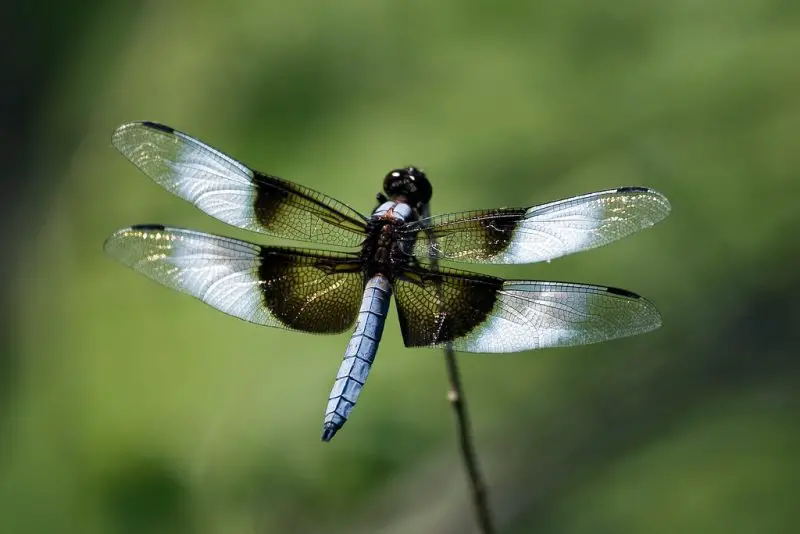
The Widow Skimmer is a medium-sized dragonfly with distinctive black wing bands bordered by white patches in males. Females lack the white markings, showing only the dark bands. Adults measure around 1.8 to 2 inches long and have broad wings that shimmer in sunlight. The combination of dark and light wing patches gives the males a ghostly appearance in flight, hence the name “Widow.”
Behaviorally, Widow Skimmers are less aggressive than many other skimmers. Males tend to perch on plants or sticks overhanging the water, making short patrols before returning to the same spot. They are often seen gliding gracefully over ponds and slow creeks, hunting for flies, mosquitoes, and small moths. Their calm and deliberate flight makes them one of the easiest species for birdwatchers and photographers to observe closely.
In California, Widow Skimmers are widespread throughout the state except in high mountain regions. They prefer still or sluggish waters—lakes, reservoirs, and marshy ponds—especially those surrounded by tall vegetation. They are commonly active from late spring through early fall, with populations peaking during warm, sunny days.
Variegated Meadowhawk (Sympetrum corruptum)
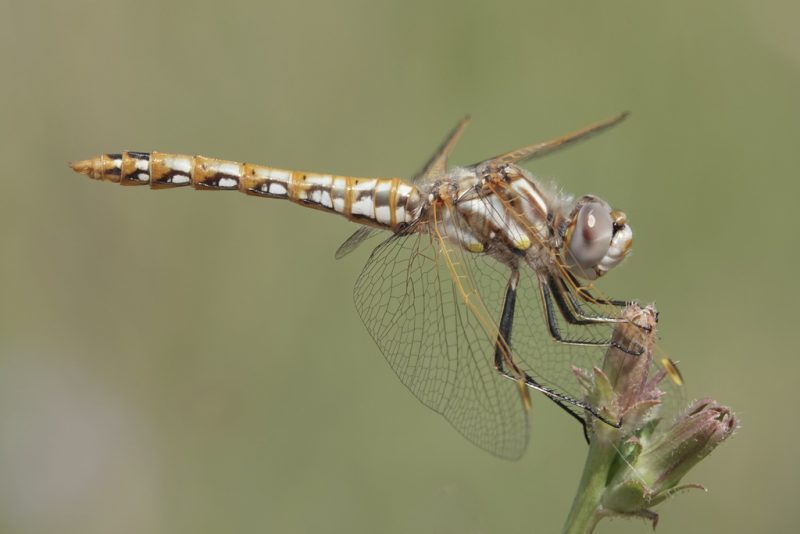
The Variegated Meadowhawk is a beautifully patterned dragonfly known for its reddish-brown and tan markings, with streaks of yellow and black along the abdomen. Males tend to display brighter red coloration, while females are more subdued in tone. Measuring about 1.6 inches long, this medium-sized species features clear wings with amber tints near the base. Its intricate coloration helps it blend perfectly into dry grasslands and rocky landscapes, giving it a distinctive, camouflaged look.
In behavior, the Variegated Meadowhawk is a strong flier and an impressive migrator, capable of traveling long distances. It often appears far from any body of water, sometimes seen in open fields, meadows, or even urban parks. Males are territorial during breeding season, frequently returning to the same perch to rest or hunt. They are agile hunters, feeding on small flying insects such as gnats and mosquitoes, often snatching prey midair.
In California, this dragonfly is widespread from the coast to the inland valleys and mountain foothills. It’s particularly common during late summer and fall when migratory movements peak. Breeding occurs in ponds, marshes, and slow-moving streams, where females deposit eggs in shallow water or among floating vegetation. Its adaptability and wide range make it one of the state’s most observed dragonfly species.
Red Saddlebags (Tramea onusta)
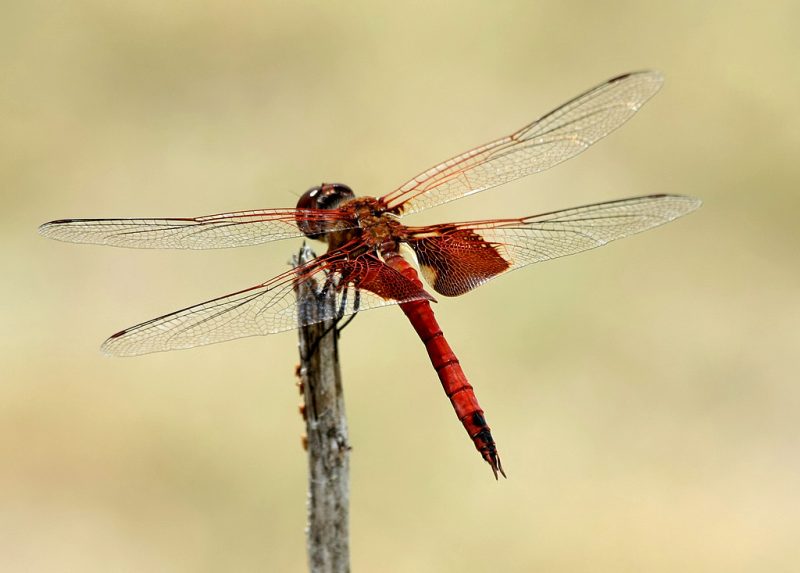
The Red Saddlebags is named for the distinctive red patches at the base of its hindwings, resembling a pair of tiny saddlebags. Its slender body is a deep crimson color, accented by translucent wings that shimmer in sunlight. Adults typically measure between 2 and 2.3 inches long. Their unique wing patches and long, sweeping flight patterns make them easy to identify as they glide effortlessly above calm water surfaces.
Behaviorally, this species is a skilled glider, spending much of its time soaring rather than hovering. Red Saddlebags often patrol open areas above ponds or lakes, occasionally perching on tall grasses or branches. Males are territorial, guarding prime breeding spots while waiting for females. During flight, they exhibit graceful, slow wingbeats that allow them to cover large areas with minimal effort, making them a captivating sight for observers.
In California, the Red Saddlebags is most commonly found in the southern and central parts of the state, particularly in warm, sunny habitats. It prefers still or gently moving water such as ponds, marshes, and reservoirs surrounded by vegetation. Though locally abundant in some areas, it is most visible during summer and early autumn when adults are most active in reproduction and feeding.
Black Saddlebags (Tramea lacerata)

The Black Saddlebags is one of the most recognizable dragonflies in California due to the large black patches at the base of its hindwings. Adults have dark brown bodies with subtle blue undertones, giving them an elegant appearance in flight. Averaging about 2.1 inches in length, this species’ broad wings and saddle-shaped markings make it stand out clearly against the sky when gliding overhead.
This dragonfly is a highly migratory and social species, often seen flying in loose groups or swarms. They are powerful gliders, spending much of their time in the air feeding on flying insects. During migration, large numbers can be seen traveling south in late summer and early fall. Males patrol open water surfaces and occasionally land on twigs or reeds, while females are less visible except during mating and egg-laying.
In California, Black Saddlebags are widespread across the state and particularly abundant in warmer months. They thrive in wetlands, ponds, and quiet lakes, though they can also appear miles away from water during migration. Their larvae develop in shallow water bodies, where they feed on mosquito larvae and aquatic insects, contributing significantly to natural pest control.
Cardinal Meadowhawk (Sympetrum illotum)
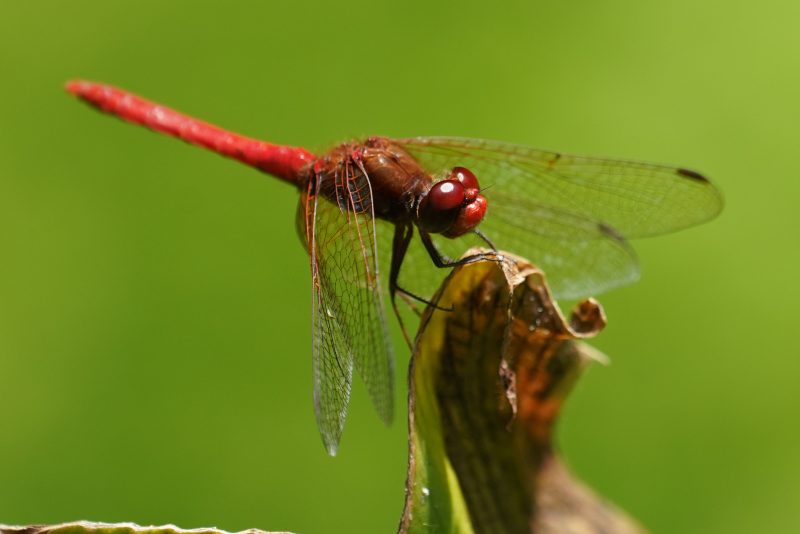
The Cardinal Meadowhawk is one of California’s most brilliant dragonflies, with adult males exhibiting a vivid scarlet body that glows in sunlight. The face is bright red, and the wings are tinted amber near the base. Females and immature individuals show more subdued orange-brown tones. Averaging about 1.7 inches in length, the species has a compact body and clear wings that make it especially eye-catching when flying over reflective water.
This dragonfly is active, alert, and highly territorial. Males are known to perch conspicuously on reeds or rocks near ponds, guarding their territories against rivals. They often return to the same perch repeatedly after brief hunting flights. Cardinal Meadowhawks are strong fliers, capable of quick takeoffs to capture mosquitoes and small flying insects. Their calm hovering and bright coloration make them favorites among nature photographers.
In California, Cardinal Meadowhawks are common across coastal, central, and southern regions. They inhabit ponds, ditches, marshes, and slow-moving streams, especially those with plenty of aquatic vegetation. They are most active from late spring through autumn, particularly in sunny, open areas. The species adapts well to human-altered environments and is frequently seen around garden ponds and irrigation canals.
Paddle-Tailed Darner (Aeshna palmata)
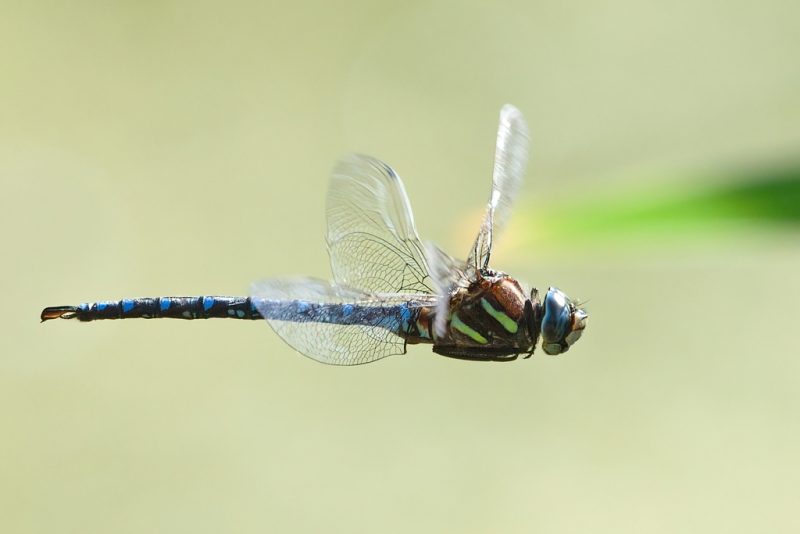
The Paddle-Tailed Darner is a large dragonfly recognized by its bright blue markings and slightly flattened tail tip that resembles a paddle. Males have striking blue spots along their abdomen, while females display a mix of green and brown patterns. Adults typically grow between 2.6 and 3 inches long, making them one of the larger darners in the western United States. Their large, glassy wings and intricate coloration make them a beautiful sight along forested streams.
In terms of behavior, Paddle-Tailed Darners are fast, agile fliers that rarely rest for long. Males patrol territories along lakeshores or stream banks, often flying back and forth in search of mates. They are powerful hunters capable of capturing mosquitoes, midges, and other flying insects mid-flight. Females lay their eggs in submerged vegetation, and the aquatic larvae are equally fierce predators that feed on tadpoles and aquatic insect larvae.
In California, this species is widespread in mountain and foothill regions, especially around cool, forested lakes and streams in northern and eastern parts of the state. It prefers clear, well-oxygenated water and shaded environments. Paddle-Tailed Darners are typically seen during summer and early autumn, and their fast, looping flight patterns make them one of the most exciting species to watch in the field.
Shadow Darner (Aeshna umbrosa)
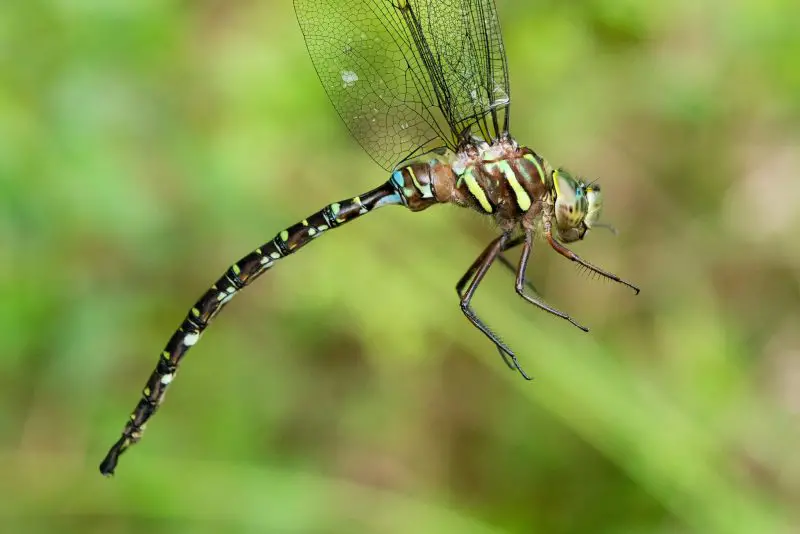
The Shadow Darner is a late-season dragonfly known for its ability to remain active even on cloudy or cool days when most other species rest. It has a dark brown body with vivid blue and green markings that stand out beautifully in dim light. Measuring around 2.8 to 3 inches in length, this large darner has clear wings with slight amber veins and large, bright green eyes that give it excellent vision for hunting in shaded environments.
Behaviorally, Shadow Darners are persistent hunters that patrol slowly along forest trails, stream edges, and shaded ponds. Males are territorial, flying back and forth over small stretches of water in search of intruders or potential mates. They rarely rest for long, but when they do, they hang vertically from low vegetation—a trait that helps distinguish them from other darners. Their flight is steady, powerful, and graceful, allowing them to pursue insects in dimly lit habitats.
In California, this species is most commonly found in the northern and mountainous regions, especially in cool, forested wetlands. They thrive in shaded ponds, woodland streams, and boggy areas surrounded by dense vegetation. Their ability to tolerate lower temperatures allows them to remain active late into autumn, making them one of the last dragonfly species seen each year in the state’s higher elevations.
Common Whitetail (Plathemis lydia)
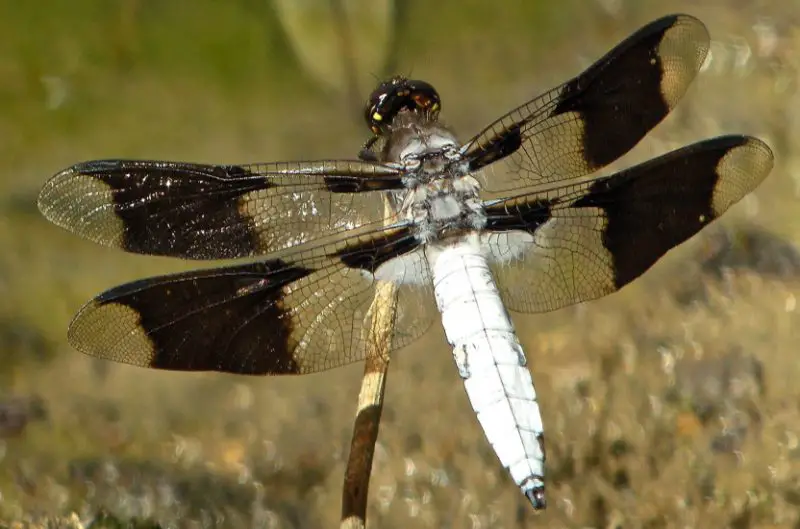
The Common Whitetail is one of the most familiar and easily recognized dragonflies across California. Males are striking, with a chalky white abdomen and dark brown wing bands, while females have brown bodies with yellow stripes and transparent wings marked by smaller dark patches. Adults measure about 1.8 to 2 inches long and have a robust, flattened body that makes them appear stockier than many other species.
This species is active, territorial, and often seen perching on rocks or twigs near the water. Males defend their small territories aggressively, making short flights to chase rivals or attract females. They spend much of their time resting on sunlit ground, occasionally darting out to capture prey in flight. Common Whitetails feed on mosquitoes, small flies, and gnats, making them valuable allies for natural pest control.
Common Whitetails inhabit ponds, lakes, and slow-moving streams throughout California, from the lowlands to the foothills. They are especially common in sunny, open areas with muddy or sandy banks. The larvae live in shallow water and prefer habitats with vegetation or submerged debris for shelter. Their broad adaptability and bold appearance make them one of the state’s most frequently observed dragonflies.
Eight-Spotted Skimmer (Libellula forensis)
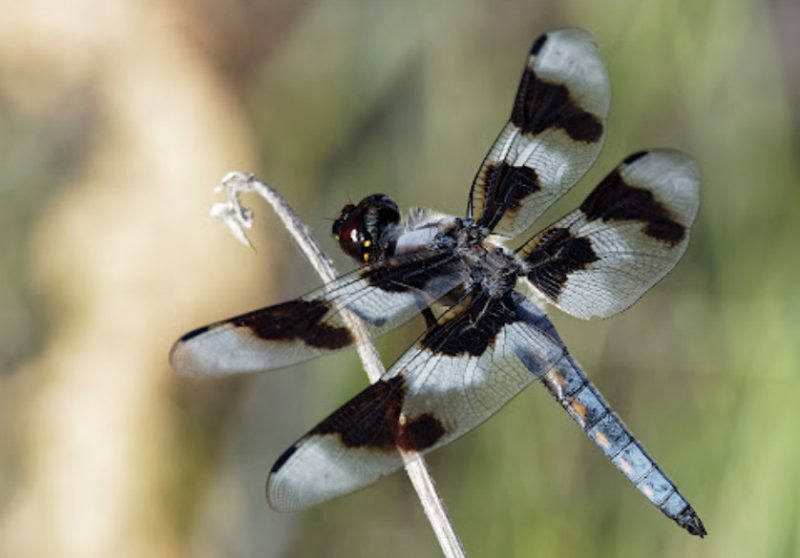
The Eight-Spotted Skimmer is easily identified by its unique wing pattern—each wing features four dark spots, and males also display four white patches between them. This gives the species a distinct black-and-white appearance when seen in flight. Adults grow to about 2 inches long, with sturdy bodies and wide wings that allow stable flight over still water. Females have similar markings but tend to be duller in color.
Behaviorally, the Eight-Spotted Skimmer is a calm and confident flier. Males often patrol small stretches of water, hovering briefly before returning to favored perches. They are not as aggressive as some other skimmers, spending long periods basking in the sun. Both males and females feed on small flying insects, often capturing prey midair with remarkable precision.
This species is widespread throughout California and is especially common in lowland regions and foothill ponds. It prefers calm, sunlit waters such as marshes, lakes, and slow creeks. Eight-Spotted Skimmers are active from late spring through early fall, and their distinctive wing markings make them a favorite among photographers and dragonfly enthusiasts across the western United States.
Desert Whitetail (Plathemis subornata)
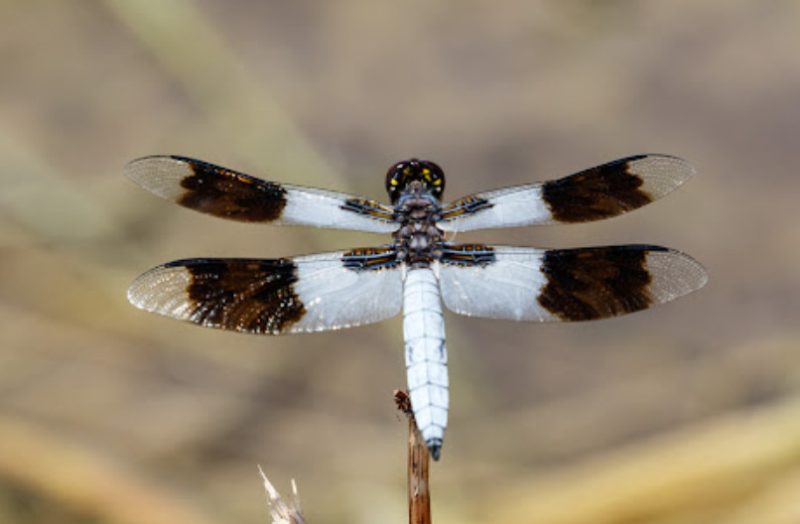
The Desert Whitetail is a hardy dragonfly adapted to California’s dry southern regions. Males have a powdery blue abdomen and dark-tipped wings, while females are brownish-yellow with intricate black striping. Adults typically measure around 1.5 to 2 inches in length. Their coloration helps them blend into sandy, rocky environments where they rest during the heat of the day.
This species is well-suited to desert life, capable of withstanding high temperatures that would drive other dragonflies to shade. Males often perch on sunlit rocks or twigs near water, darting out swiftly to catch prey or chase rivals. Their flight is short and direct, and they often return to the same perch repeatedly. Desert Whitetails are voracious insect predators, feeding on flies, beetles, and even small moths.
In California, they are most abundant in the southern deserts, including the Mojave and Colorado regions. They inhabit artificial ponds, cattle troughs, and small desert streams where water is scarce but persistent. Their larvae develop quickly in shallow pools that may dry up seasonally, a remarkable adaptation to the desert’s harsh climate.
Blue-Eyed Darner (Rhionaeschna multicolor)
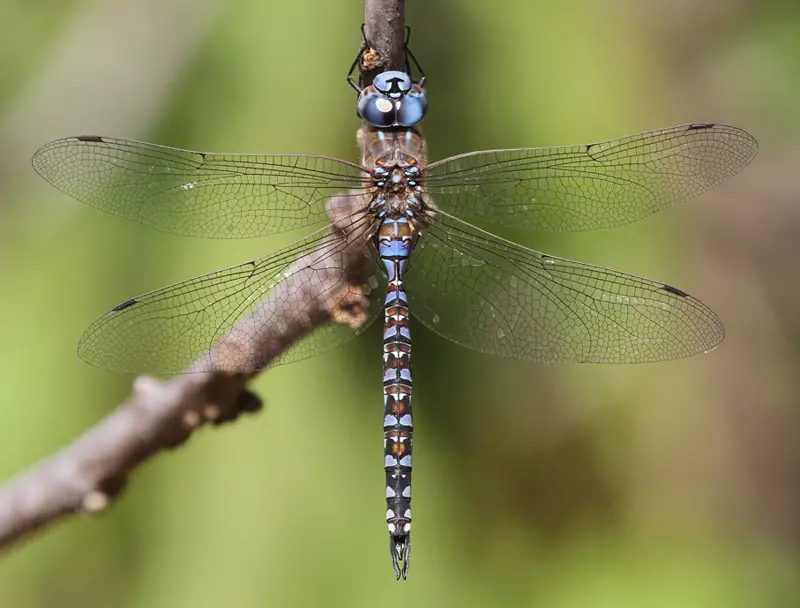
The Blue-Eyed Darner is among California’s most stunning dragonflies, famous for its brilliant blue eyes and green-striped thorax. Its abdomen is marked with alternating blue and black segments, creating a mesmerizing pattern in flight. Adults can reach about 2.5 to 3 inches long and have a slender, streamlined body built for speed and endurance. Males tend to be more vividly colored than females, whose hues are softer and more brownish-green.
Behaviorally, the Blue-Eyed Darner is a fast, active flier, often seen darting across open fields, meadows, and gardens far from water. Unlike many dragonflies, it frequently forages away from aquatic habitats, making it a familiar sight even in urban parks. Males patrol open airspaces in looping flight paths, while females are more elusive, typically appearing near water only to lay eggs.
In California, this species is widespread and abundant from coastal plains to inland valleys and foothills. It thrives in diverse habitats, including ponds, lakes, slow rivers, and even suburban gardens. The larvae develop in still or gently flowing water and are strong predators of aquatic insects. The Blue-Eyed Darner’s brilliant color and energetic flight make it one of the most beloved and easily recognized dragonflies in the state.
Striped Meadowhawk (Sympetrum pallipes)
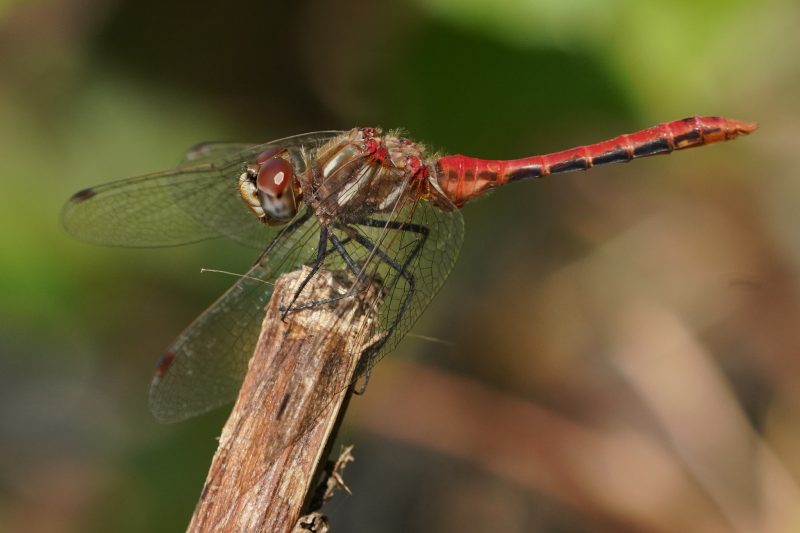
The Striped Meadowhawk is a small, delicate dragonfly known for its pale red or reddish-orange body and distinctive light stripes running along its thorax. Adults typically reach about 1.5 inches in length, with clear wings that shimmer faintly in sunlight. Males are bright red, while females and immature individuals are more subdued in color, often displaying orange-brown tones. Its slim body and intricate markings give it a refined, elegant appearance when seen resting on rocks or dry vegetation.
Behaviorally, the Striped Meadowhawk is calm and often perches in open, sunlit areas. Males establish small territories near ponds or shallow pools, waiting patiently for females to approach. Their flight is gentle and hovering, staying close to the ground as they patrol for prey such as mosquitoes and small flies. They are especially tolerant of warm, dry weather, making them a common sight during California’s long summer months.
In California, this species is widespread across foothills, valleys, and grasslands. It prefers still or slow-moving waters with sparse vegetation, often appearing in irrigation ditches, temporary pools, or open meadows after rainfall. Because of its adaptability and bright color, the Striped Meadowhawk is frequently observed in both natural and suburban landscapes during late summer and early autumn.
Pacific Spiketail (Cordulegaster dorsalis)
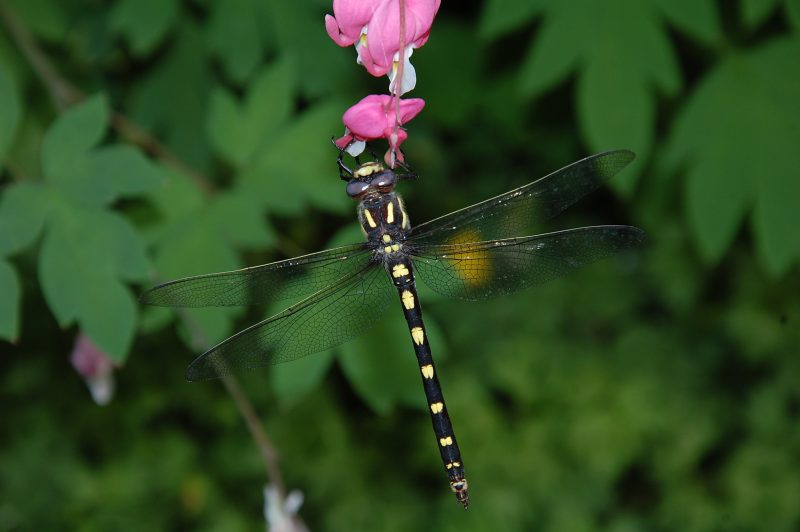
The Pacific Spiketail is a large and striking dragonfly, easily identified by its black body marked with vivid yellow bands. Adults can grow up to 3.3 inches long, with long, narrow wings and a strong, tapered abdomen ending in a small “spike.” This size and coloration give it a bold, wasp-like appearance. Males and females look similar, though females tend to be slightly larger with a more pronounced tail tip used for egg-laying.
This species is a powerful and fast flier, known for its territorial nature. Males patrol long stretches of mountain streams or shaded creeks, flying back and forth just above the water in search of rivals or potential mates. When resting, they hang vertically from branches or plants near the water’s edge. Pacific Spiketails are skilled hunters that feed on flying insects, capturing them midair with incredible precision and speed.
In California, the Pacific Spiketail is most commonly found in the northern and central parts of the state, especially in the Sierra Nevada foothills and forested mountain regions. It prefers clear, cool streams with rocky bottoms, often within shaded woodlands. The larvae live in the substrate of these streams and are fierce aquatic predators. This species is a strong indicator of healthy, unpolluted water systems and is often used by researchers to assess ecosystem quality.
California Darner (Rhionaeschna californica)
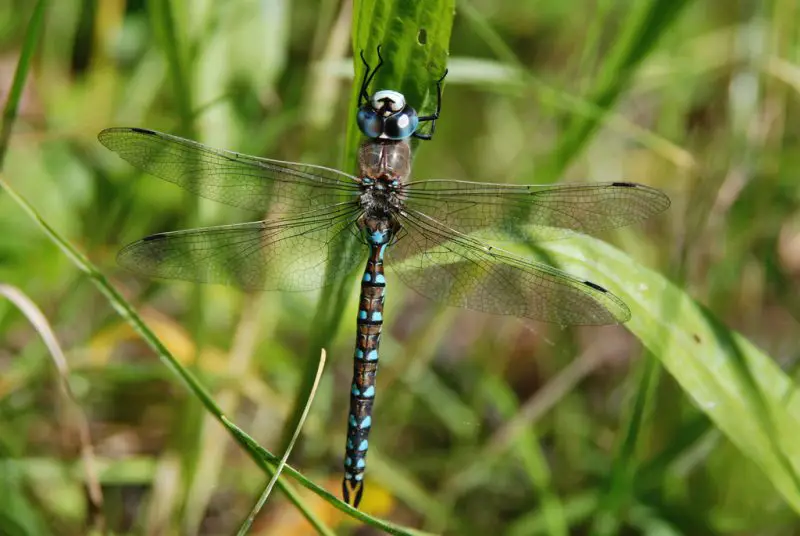
The California Darner, named after the state itself, is a distinctive dragonfly recognized by its bright blue abdominal markings and green-striped thorax. Adults measure between 2.5 and 3 inches long and are sleek, streamlined fliers. The large, multifaceted eyes are typically blue or green, giving them excellent vision for detecting prey and rivals. Males are brilliantly colored, while females often display more muted greenish-brown tones.
In behavior, California Darners are strong, agile fliers that patrol low over open water and along stream edges. Males are territorial, frequently returning to the same section of shoreline after short flights. They capture small flying insects such as midges, gnats, and mosquitoes with quick aerial maneuvers. Females lay their eggs on submerged vegetation or mud near water’s edge, where their larvae develop into robust aquatic predators.
This species inhabits a wide range of environments across California, from coastal marshes and inland ponds to high-altitude lakes and mountain meadows. It is most active from late spring through early fall and thrives in both natural and human-made wetlands. Its abundance and adaptability make it one of California’s most characteristic dragonfly species.
Wandering Glider (Pantala flavescens)
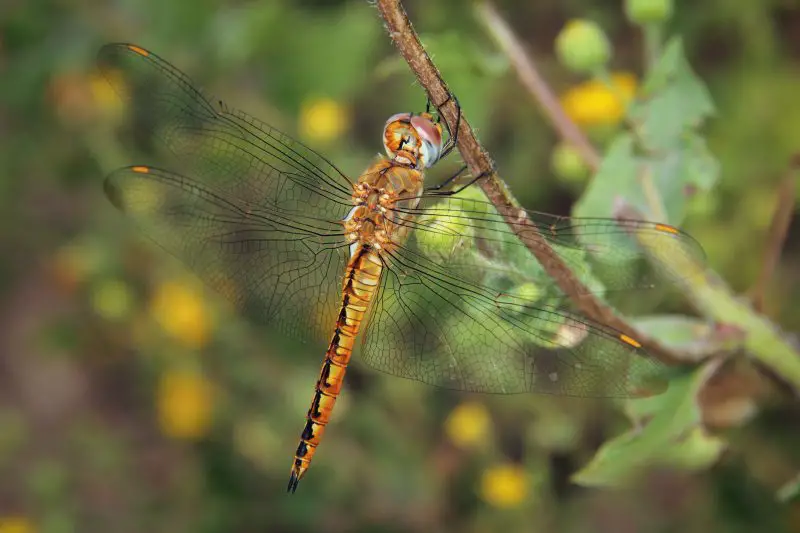
The Wandering Glider is one of the world’s most widespread dragonflies and a remarkable long-distance traveler. Adults are golden-yellow to orange, with broad wings that give them excellent gliding ability. Measuring about 2 inches in length, this species has a short, rounded abdomen and a light, agile frame. Its bright color makes it easily visible as it soars through open skies, often far from water.
Behaviorally, the Wandering Glider is known for its extraordinary migratory behavior, capable of crossing oceans and continents. It spends much of its life in flight, gliding effortlessly on warm air currents. Males rarely defend territories; instead, they roam vast distances in search of temporary pools for breeding. Females lay eggs in puddles, rain-filled ditches, or even water collected on roadsides, demonstrating exceptional adaptability.
In California, the Wandering Glider can be found statewide, from coastal regions to arid deserts. It breeds opportunistically wherever standing water appears, particularly after summer rains. Because of its migratory nature, individuals can be seen nearly year-round in warmer regions. This species plays a valuable role in controlling mosquito populations and serves as a symbol of endurance and adaptability among dragonflies.
Western Pondhawk (Erythemis collocata)
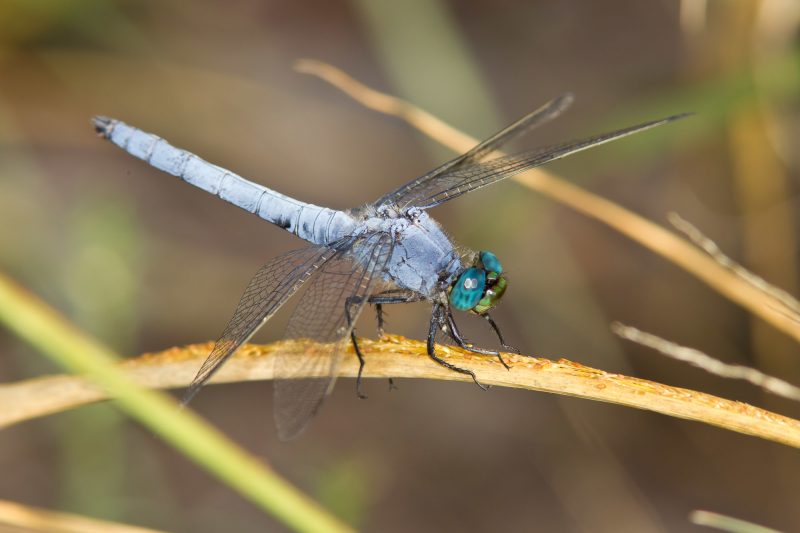
The Western Pondhawk is a medium-sized dragonfly notable for its vivid sexual dimorphism. Males develop a powdery blue color as they mature, while females retain a bright green thorax with black striping along the abdomen. Adults measure around 1.8 to 2 inches in length, with broad, transparent wings and a strong, compact body. The contrast between male and female coloration makes this species particularly striking when both are present near the same pond.
This dragonfly is an energetic hunter and a frequent perch-dweller. Males often claim territories along pond edges or marshy areas, perching on rocks or low vegetation before darting out to capture prey. They feed on small flying insects such as flies and mosquitoes, using agile midair movements. Females are less territorial and are usually seen flying low over water during egg-laying.
In California, Western Pondhawks are widespread in wetlands, lakes, irrigation canals, and slow-moving rivers. They are especially abundant in the Central Valley and coastal regions during the summer. Their larvae live among aquatic plants and are effective predators of mosquito larvae and tadpoles. This adaptability and their tolerance for human-altered environments make them one of the most frequently observed dragonflies in the western United States.
Autumn Meadowhawk (Sympetrum vicinum)
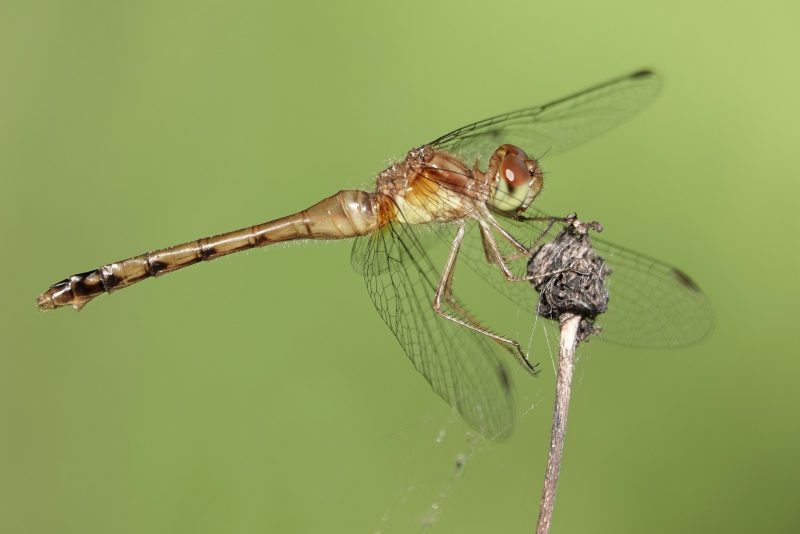
The Autumn Meadowhawk is one of California’s latest-flying dragonflies, often active well into November when most other species have disappeared. Adults are small, about 1.4 inches long, and are easily recognized by their deep red bodies and clear wings. Males are a rich crimson color, while females range from yellowish-orange to reddish-brown. Their slender form and bright coloring make them particularly striking against the fading vegetation of late autumn.
Behaviorally, the Autumn Meadowhawk is gentle and approachable, often perching on bare ground, rocks, or fallen leaves to bask in the low autumn sun. They are less territorial than many other meadowhawks, preferring to rest quietly between brief hunting flights. Their diet consists of small flying insects, including gnats and mosquitoes, which they capture with swift, precise movements. Even during cooler days, they remain active by seeking out sunny spots for warmth.
In California, this dragonfly is found mainly in northern and central regions, particularly around marshes, ponds, and meadows. It thrives in calm, shallow wetlands where vegetation provides cover for breeding. Its presence late in the year makes it an important pollinator and insect predator during a time when few other aerial hunters remain. The Autumn Meadowhawk’s resilience and color have earned it admiration among naturalists who appreciate its endurance through the changing seasons.
Spot-Winged Glider (Pantala hymenaea)
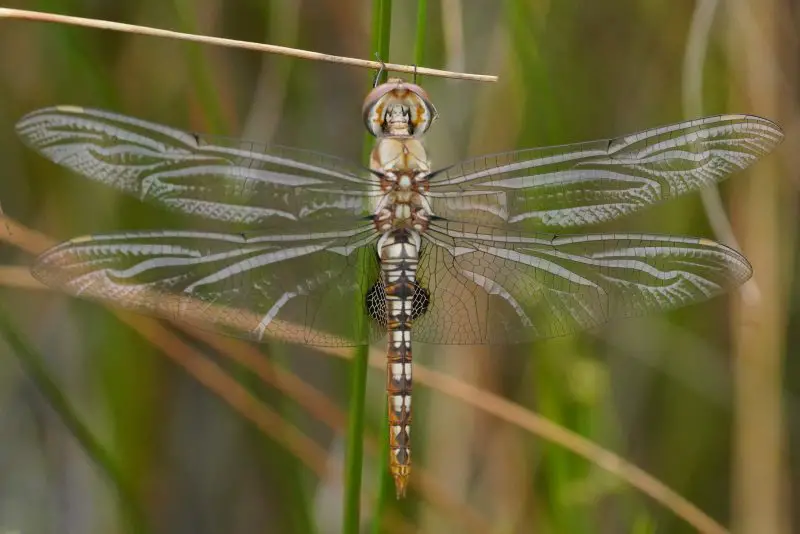
The Spot-Winged Glider is a graceful migratory dragonfly distinguished by the small amber-brown spots near the base of its hindwings. Adults have a golden to reddish-brown body and measure about 2.2 inches in length. Their long, transparent wings are broad and adapted for gliding on thermal currents. Males and females look similar, though females are often slightly larger and rounder in build.
This species is known for its impressive aerial behavior, spending much of its time flying high above the ground. It rarely perches, instead gliding effortlessly in open skies over fields, lakes, and even city streets. Spot-Winged Gliders are opportunistic migrants, traveling vast distances in response to rainfall patterns and breeding opportunities. They breed in temporary pools, where females lay eggs quickly before the water evaporates, ensuring their larvae can develop rapidly.
In California, these dragonflies are most often seen during late summer and early autumn, especially in warm, humid conditions. They are found across both coastal and inland regions, often appearing in great numbers after seasonal storms. Their wide-ranging flight behavior and adaptability make them one of the most fascinating migratory dragonflies in North America.
Western Red Darter (Sympetrum madidum)
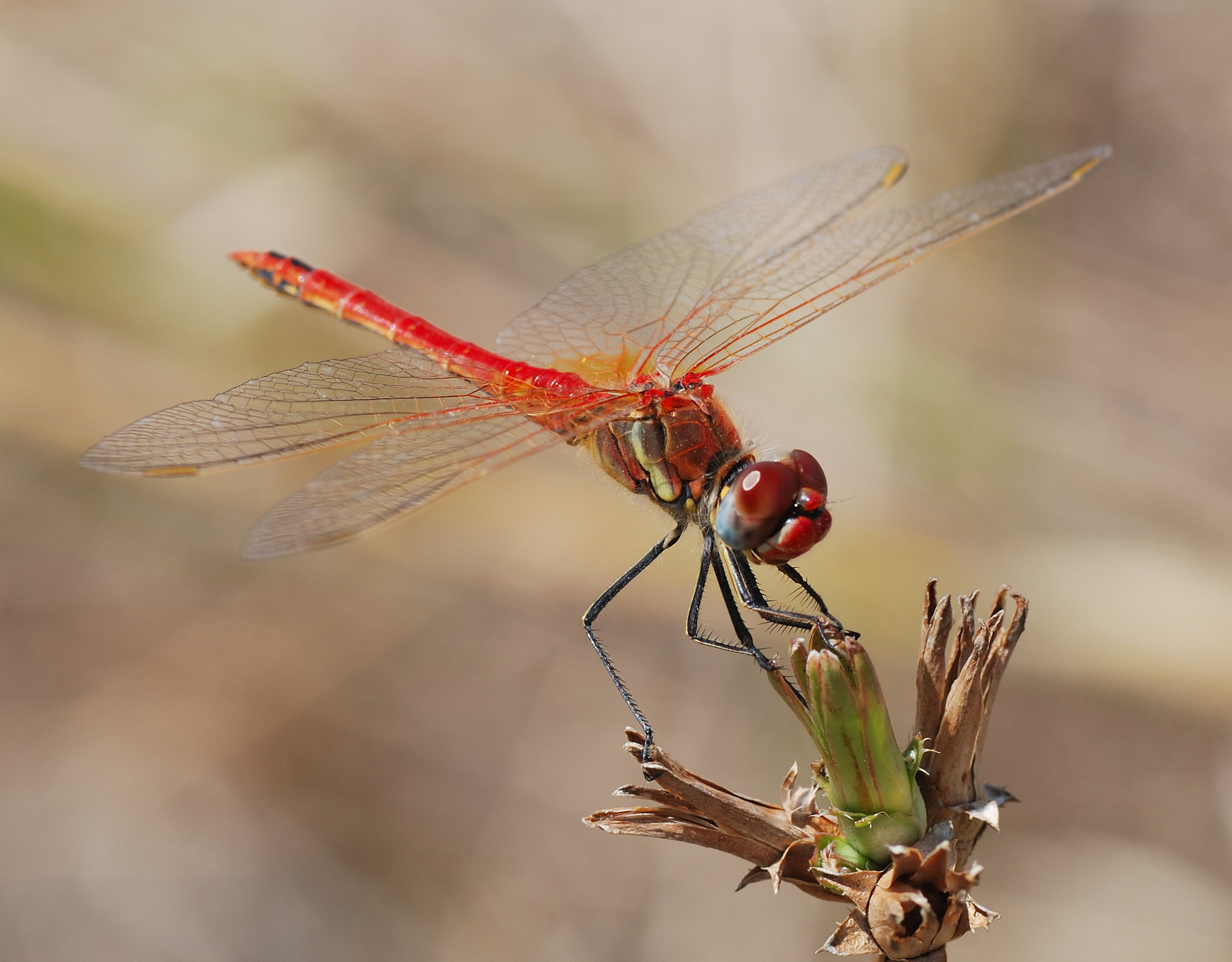
The Western Red Darter is a small, compact dragonfly notable for its deep red to brick-orange coloration. Adults typically measure about 1.3 to 1.6 inches long, with clear wings and dark veins that contrast beautifully with their warm-toned bodies. Males are more vibrantly colored, while females are often yellowish-orange. The species has a simple yet elegant appearance, perfectly suited to its cool, northern habitats.
In behavior, the Western Red Darter is calm and often perches on low vegetation or rocks near water. Males are mildly territorial but not aggressive, spending much of their time basking or making short flights to capture insects. These dragonflies are most active during the cooler parts of the day, often seen in the morning and late afternoon. Their gentle hovering and tendency to remain near water’s edge make them easy to observe closely.
In California, this species is most abundant in the northern and high-elevation regions, particularly near forest ponds, meadow lakes, and the edges of mountain wetlands. It prefers cooler, moist habitats with ample vegetation and clear water. The larvae live among aquatic plants and feed on small aquatic invertebrates. The Western Red Darter’s presence is often a sign of a healthy, undisturbed wetland ecosystem.
Tule Bluet (Enallagma carunculatum)
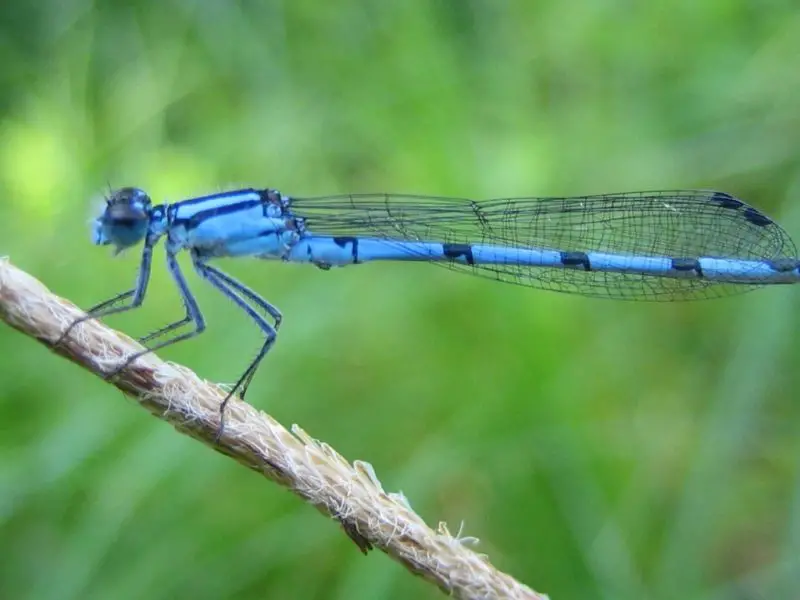
The Tule Bluet is a damselfly, a close relative of true dragonflies, known for its slender body and bright blue coloration. Adults measure about 1.2 inches long, with a narrow abdomen marked by alternating blue and black segments. The head and thorax are a brilliant sky blue, and their delicate, transparent wings fold neatly along the body when at rest—a key difference from dragonflies. Males are more vivid in color, while females are paler or even brownish in hue.
Behaviorally, Tule Bluets are calm and often seen in small groups near still or slow-moving water. They spend much of their time resting on reeds, grasses, or floating plants. Their flight is light and fluttery, staying close to the surface of ponds or marshes. Mating pairs often remain joined in the “wheel” position while flying or perching, and females lay eggs on submerged vegetation just below the water’s surface.
In California, the Tule Bluet is widespread across lowland and foothill regions, especially around lakes, reservoirs, and marshes with dense tule reeds or cattails. It is common in both natural and artificial wetlands and can even be found in urban ponds. Because of its abundance and visibility, this damselfly is a familiar sight during summer months and is often one of the first species identified by beginner observers.
Emma’s Dancer (Argia emma)
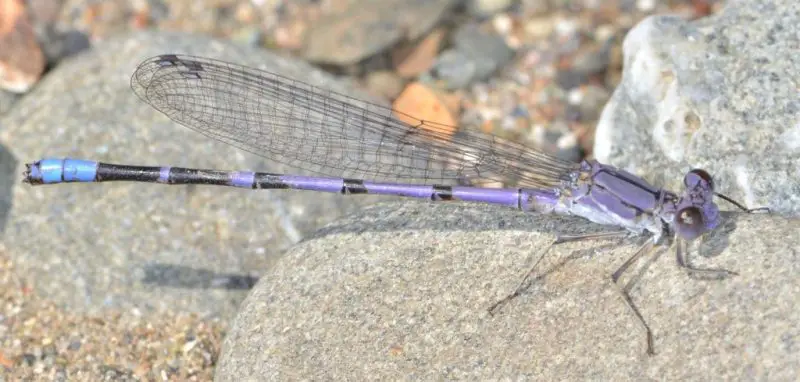
Emma’s Dancer is a slender and graceful damselfly recognized by its soft violet to lavender body and clear, delicate wings. Adults typically measure around 1.4 inches long, with long legs and a narrow abdomen. The subtle coloring gives them an elegant appearance, especially in sunlight where their bodies seem to shimmer with a purplish hue. Males are more vibrantly colored, while females have duller, brownish tones.
This damselfly is a patient and agile flyer, often seen fluttering low along streams or perching on rocks near moving water. Unlike some damselflies that gather in large groups, Emma’s Dancer tends to be solitary or found in small numbers. It perches frequently, holding its wings partially open in a characteristic pose that helps distinguish it from other species. Its diet consists primarily of tiny flying insects caught in midair.
In California, Emma’s Dancer is found mostly in the northern mountain regions, particularly near forested creeks and cool, clear rivers. It thrives in shaded stream habitats with abundant boulders or exposed roots for perching. The larvae develop in fast-flowing water and are adapted to cling to submerged stones. Its presence is a hallmark of clean, unpolluted streams and adds a touch of color to California’s northern wilderness.
Western River Cruiser (Macromia magnifica)
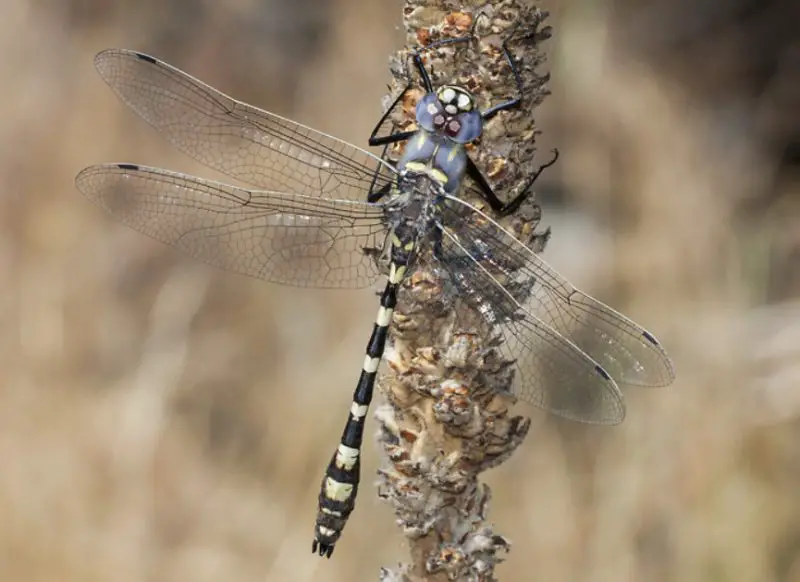
The Western River Cruiser is a large and striking dragonfly, instantly recognizable by its bold black and yellow-striped body and long, clear wings. Adults can reach lengths of up to 3.3 inches, making it one of the larger dragonflies in California. Its long, slender abdomen and metallic sheen give it an elegant appearance as it glides along streams. The eyes are bright green, positioned close together, giving it exceptional visual range while hunting.
Behaviorally, this species is a strong and tireless flier. Males are frequently seen patrolling long stretches of forested rivers and creeks, flying rapidly back and forth just above the water’s surface. They seldom land, preferring to remain in constant motion while searching for prey or mates. When they do perch, it is often for only a few moments on a branch or rock close to the water. Their predatory agility allows them to capture other flying insects in midair with remarkable precision.
In California, the Western River Cruiser inhabits clear, fast-flowing streams and rivers, particularly in forested or mountainous areas. It is most common in northern California and along the Sierra Nevada foothills. The larvae live in clean, oxygen-rich waters and are excellent indicators of healthy aquatic ecosystems. Because of their speed and rarity at rest, these dragonflies are a thrilling but challenging find for nature observers and photographers.
Green-Striped Darner (Aeshna verticalis)
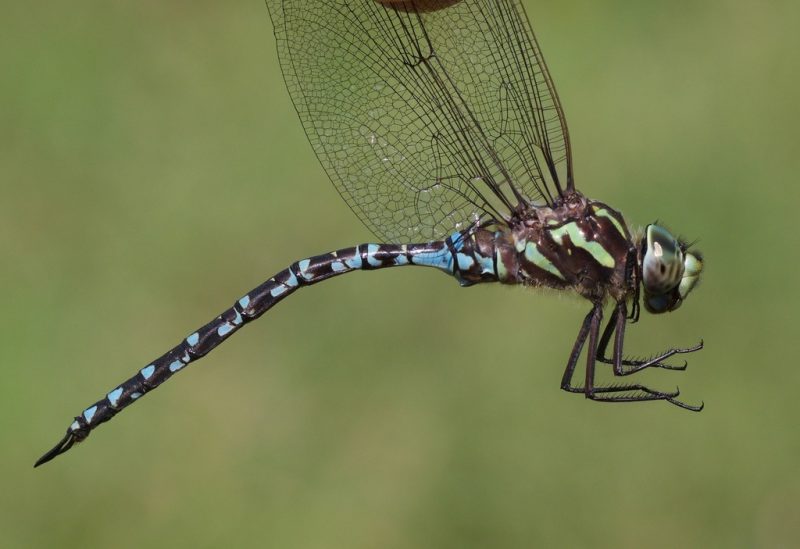
The Green-Striped Darner is a large and elegant dragonfly, known for its bright green thoracic stripes and deep blue abdominal spots. Measuring about 2.8 to 3.1 inches long, this species displays vivid contrasting colors that make it stand out among the darners. Its wings are clear with amber-tinted veins, and the combination of green and blue hues gives it a jewel-like appearance in sunlight.
This dragonfly is an active and persistent flier, often patrolling shaded streams or ponds surrounded by forest vegetation. Males are territorial, patrolling linear paths above water while searching for females. They are strong, direct fliers that can maneuver skillfully through narrow spaces in dense vegetation. Females are more secretive and typically appear near water only when laying eggs. Both sexes hunt small flying insects, which they catch with swift aerial movements.
In California, the Green-Striped Darner is primarily found in the northern part of the state, particularly in cool, shaded habitats such as forest streams and lakeshores. It thrives in moist environments with clear water and rich plant growth. The species is most active during the late summer and early fall. Its striking coloration and preference for wooded stream environments make it a favorite among dragonfly enthusiasts exploring California’s northern wilderness.
Sooty Dancer (Argia lugens)
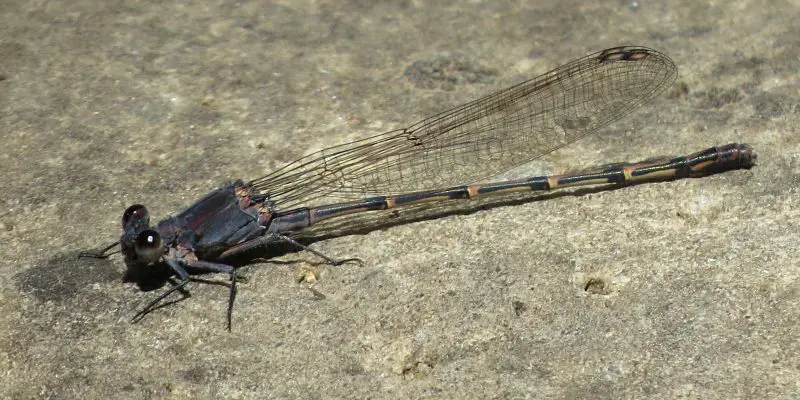
The Sooty Dancer is a small and subtle damselfly recognized by its deep brown to smoky-gray coloration. Adults measure about 1.2 inches long and have a slender body with delicate, transparent wings. Unlike the bright blue of many damselfly species, its darker tones give it a shadowy appearance, making it well-camouflaged among shaded rocks and streamside vegetation. Males are typically darker, while females are slightly paler.
Behaviorally, the Sooty Dancer prefers to stay close to the ground or low vegetation, rarely venturing far from water. It is often seen perching quietly on rocks, branches, or grasses near shaded streams. Its flight is short and gentle, and it tends to hover briefly before settling again. This calm, inconspicuous behavior makes it less noticeable than more brightly colored damselflies, though it is quite common in suitable habitats.
In California, the Sooty Dancer is widespread throughout the central and northern regions. It favors shaded creeks, small rivers, and spring-fed streams with cool, clear water. The larvae cling to submerged rocks and aquatic plants, developing in slow or moderate currents. Its presence in abundance often signals a stable stream ecosystem, and its understated beauty adds quiet charm to California’s forested waterways.
Coral-Fronted Clubtail (Stylurus plagiatus)
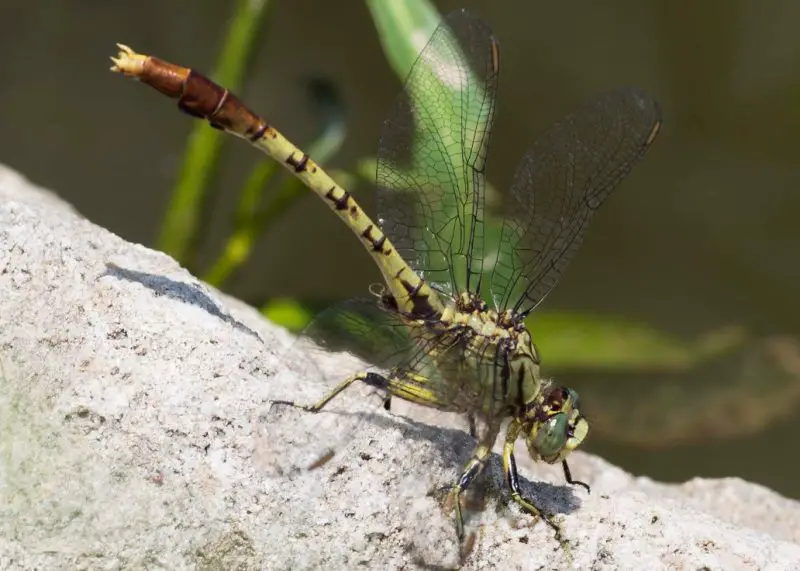
The Coral-Fronted Clubtail is a rare and striking dragonfly, notable for its black-and-yellow abdomen and distinctive coral-pink or orange face. Adults typically reach about 2.3 inches in length and feature the thickened “clubbed” tail that gives the group its name. The contrasting body colors and reddish head make this species one of the most visually unusual dragonflies found in California.
In terms of behavior, the Coral-Fronted Clubtail is strong but deliberate in flight. Males patrol low over fast-moving streams and rivers, often keeping close to the surface. They perch occasionally on rocks or branches near the water but are generally elusive. Their larvae live in sandy or gravelly riverbeds, where they are ambush predators feeding on aquatic invertebrates. Because of their preference for clean, flowing water, they are sensitive to pollution and habitat disturbance.
In California, this species occurs mainly in the Sierra Nevada and Cascade Range regions, where cool, swift streams provide ideal breeding sites. It is considered uncommon, and sightings are infrequent, making it a prized observation for dragonfly enthusiasts. The Coral-Fronted Clubtail’s rarity and distinctive coloration make it a highlight of California’s mountainous river ecosystems.
Red Rock Skimmer (Paltothemis lineatipes)
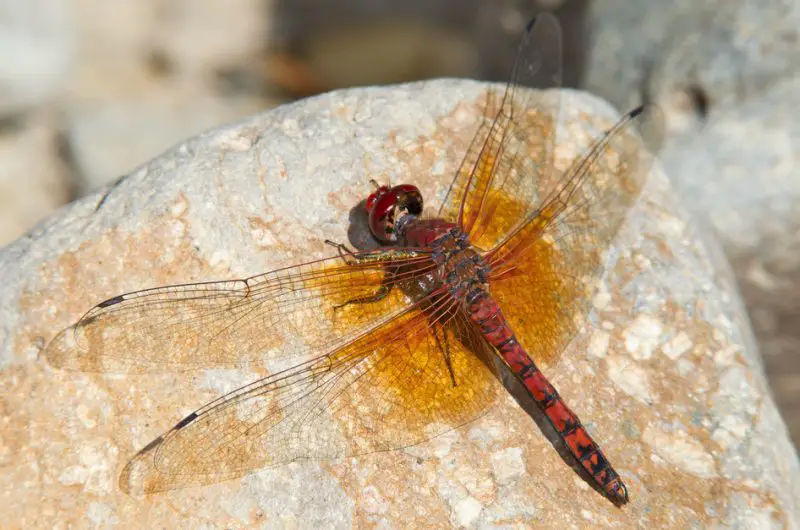
The Red Rock Skimmer is a colorful dragonfly native to the arid southwestern United States, including southern California. Adults are medium-sized, about 1.8 to 2 inches long, with brick-red bodies accented by yellow side stripes and clear wings with amber tinges at the base. The combination of red and gold tones gives them a vibrant, desert-adapted appearance. Males and females share similar coloration, though males are often brighter overall.
Behaviorally, this species is a sun-loving and energetic flier. Males often perch on rocks near water, darting out quickly to chase rivals or capture prey. They are highly territorial and can often be seen returning to the same sunny perch multiple times. Red Rock Skimmers feed on small flying insects and are especially active during the hottest parts of the day, when few other dragonflies are present.
In California, the Red Rock Skimmer is most common in southern desert regions, including rocky streams, desert ponds, and canyon pools. It thrives in areas with warm temperatures and sparse vegetation. Despite the arid habitat, it depends on small, reliable water sources for breeding. Its adaptability to harsh desert environments and its vivid coloration make it one of the most fascinating dragonflies of southern California’s rugged landscapes.
FAQs about Dragonflies in California
Dragonflies are among the most fascinating insects found throughout California, admired for their dazzling colors, swift flight, and ecological importance. Below are some frequently asked questions (FAQs) about California’s dragonflies, covering everything from identification to behavior and conservation.
What time of year can you see dragonflies in California?
Dragonflies in California are most active from late spring through early autumn, typically between April and October. In warmer southern regions, species such as the Red Rock Skimmer and Flame Skimmer may appear as early as March. Some species, like the Autumn Meadowhawk, continue flying into November, especially in northern California wetlands. Activity peaks during warm, sunny days when adults are feeding, mating, and defending territories.
Where are dragonflies most commonly found in California?
Dragonflies thrive near freshwater habitats, including ponds, lakes, marshes, rivers, and even irrigation ditches. Each species has specific preferences — for example, the Pacific Spiketail prefers cool mountain streams, while the Desert Whitetail and Red Rock Skimmer are adapted to hot, arid desert pools. Urban parks and gardens with ponds also attract common species such as the Blue Dasher and Western Pondhawk.
Do dragonflies live year-round in California?
No, adult dragonflies do not live throughout the entire year. Most species have an annual life cycle, spending the majority of their lives in the larval (nymph) stage underwater, which can last from several months to a few years depending on the species. Adults typically live for a few weeks to a couple of months, emerging during the warmest parts of the year to reproduce. In southern California, mild winters may allow larvae to develop continuously, leading to overlapping generations.
Are dragonflies beneficial to the environment?
Yes, dragonflies play a vital ecological role in controlling insect populations. Both adults and larvae are voracious predators that feed on mosquitoes, midges, flies, and other small insects. By reducing mosquito populations, they help limit the spread of diseases such as West Nile virus. In addition, dragonflies serve as important indicators of water quality, as many species require clean, oxygen-rich habitats for their larvae to thrive.
What is the difference between dragonflies and damselflies?
Dragonflies and damselflies belong to the same order, Odonata, but differ in appearance and behavior.
- Dragonflies (suborder Anisoptera) hold their wings open horizontally when resting, have thicker bodies, and are strong, fast fliers.
- Damselflies (suborder Zygoptera), such as the Tule Bluet and Emma’s Dancer, have slender bodies, hold their wings together above their backs when resting, and fly more delicately. Both groups share similar habitats and life cycles.
Do dragonflies bite or sting humans?
Dragonflies do not sting, and they rarely bite humans. Their strong jaws are used to catch and consume small insects, not for defense. While they may bite if handled roughly, the bite is harmless and does not break the skin. Dragonflies are completely non-aggressive toward humans and are safe to observe up close.
Why do dragonflies have such bright colors?
Dragonflies’ vivid hues — reds, blues, greens, and golds — come from pigments and structural colors in their bodies and wings. These colors play important roles in mating displays, territorial defense, and camouflage. For instance, the Cardinal Meadowhawk uses its brilliant red coloration to attract females, while the Green-Striped Darner blends perfectly with its forested surroundings. Some species even change color slightly as they age or with temperature shifts.
How fast can dragonflies fly?
Dragonflies are among the fastest insects in the world. Depending on the species, they can reach speeds between 25 and 35 miles per hour (40–56 km/h). The Common Green Darner and Western River Cruiser are known for their powerful, sustained flights, capable of traveling great distances. Their agility allows them to make sharp turns, hover, or fly backward — skills that make them exceptional aerial hunters.
Are there migratory dragonflies in California?
Yes, several species in California are migratory, including the Common Green Darner, Variegated Meadowhawk, Red Saddlebags, and Wandering Glider. These dragonflies travel hundreds or even thousands of miles between breeding and overwintering sites. For example, the Wandering Glider is famous for global-scale migrations, sometimes crossing oceans and appearing on every continent except Antarctica.
How can you attract dragonflies to your garden in California?
You can attract dragonflies by creating or maintaining a small pond with shallow edges, aquatic plants, and minimal fish (since fish eat larvae). Plant native vegetation such as cattails or rushes around the water to provide perching and breeding sites. Avoid using pesticides, as they harm both adult dragonflies and their aquatic larvae. Providing a natural water source will encourage species like the Blue Dasher, Western Pondhawk, and Flame Skimmer to visit regularly.
What threats do dragonflies face in California?
The main threats to dragonflies include habitat loss, pollution, and climate change. Development around wetlands and water diversion reduce breeding sites, while pesticides and poor water quality harm larvae. Prolonged droughts and temperature fluctuations also affect the timing of emergence and migration. Conservation efforts focus on protecting wetlands, maintaining water quality, and restoring native plant habitats to support dragonfly populations.
Which dragonfly species are the easiest to spot in California?
Some of the most common and easy-to-identify dragonflies in California include the Flame Skimmer, Blue Dasher, Common Green Darner, Black Saddlebags, and Western Pondhawk. Their bright colors, active flight, and preference for open water make them highly visible even to casual observers. These species are common in both natural wetlands and urban parks across much of the state.
What does it mean when you see a dragonfly?
Culturally, dragonflies are often viewed as symbols of change, adaptability, and transformation. In many Native American and Asian traditions, they represent light, purity, and renewal. From an ecological standpoint, seeing dragonflies is also a good sign — it often indicates the presence of clean, healthy water and a balanced ecosystem.



